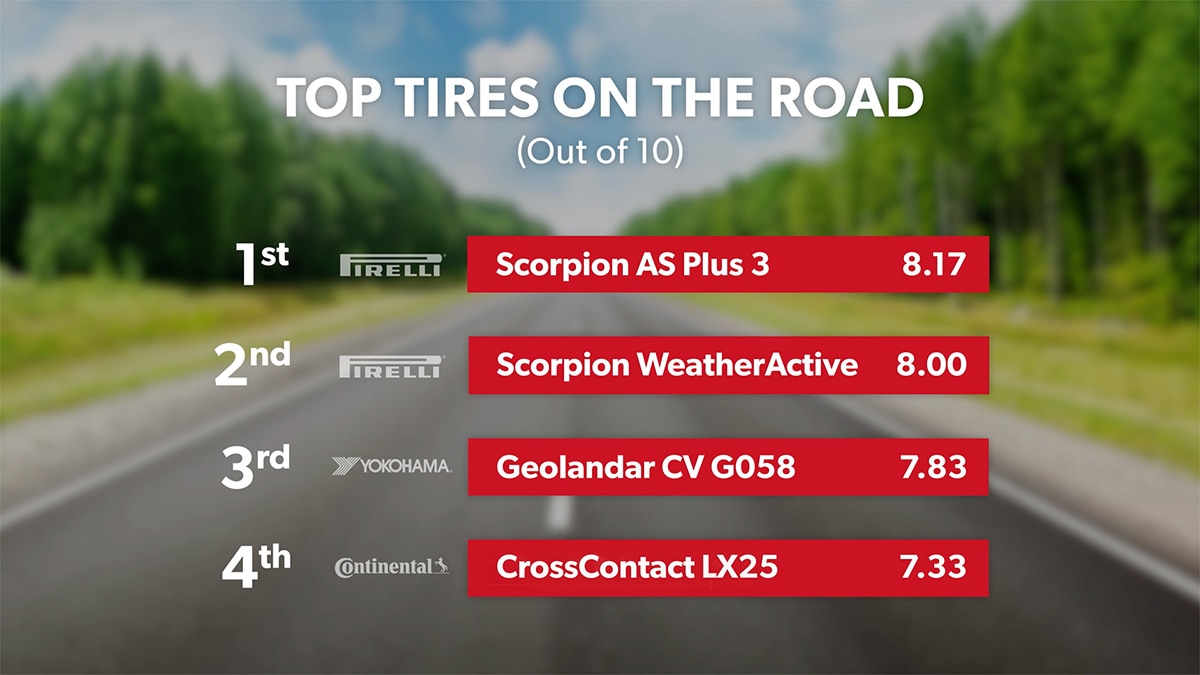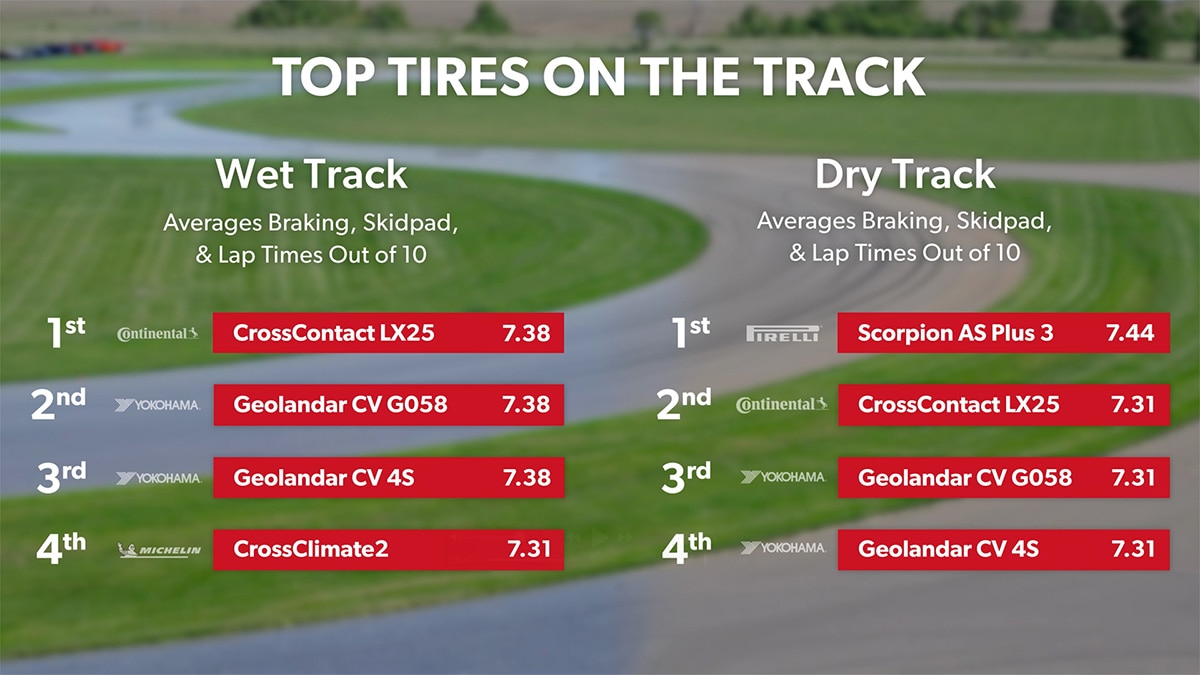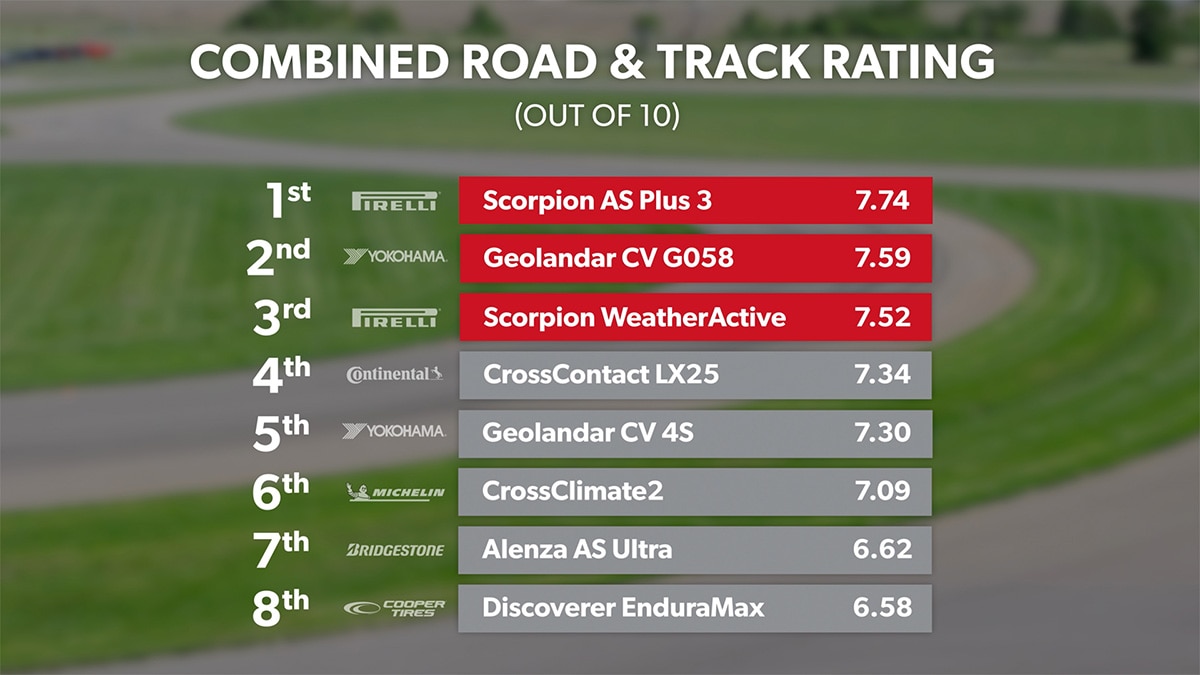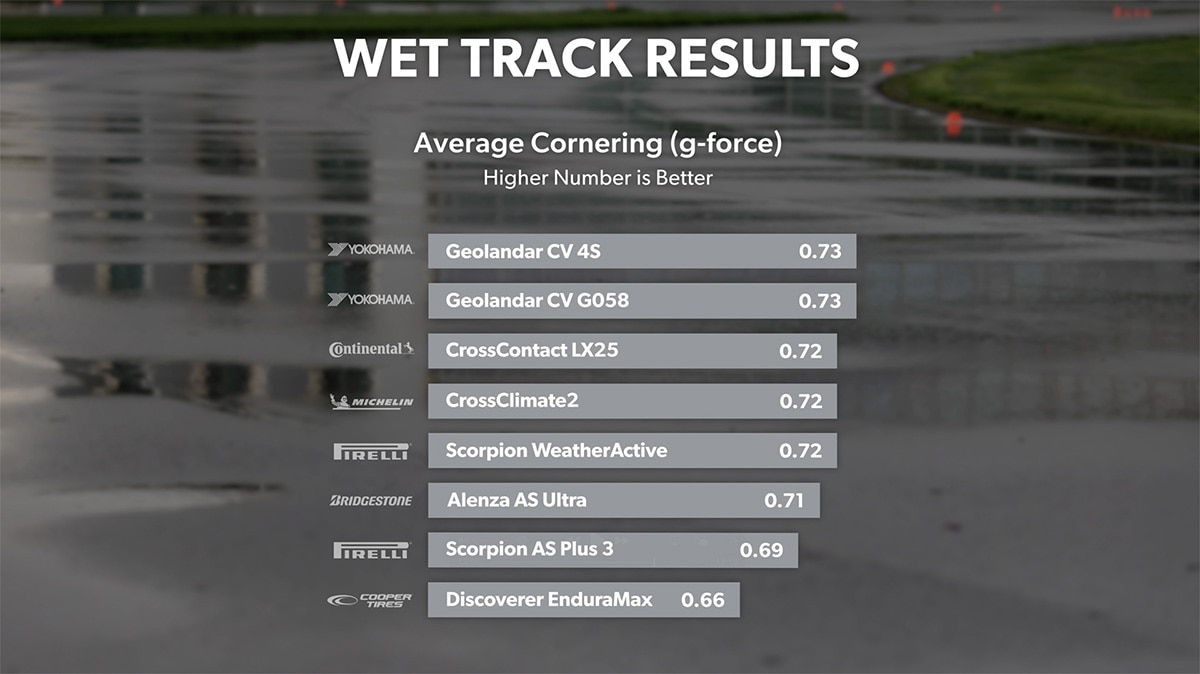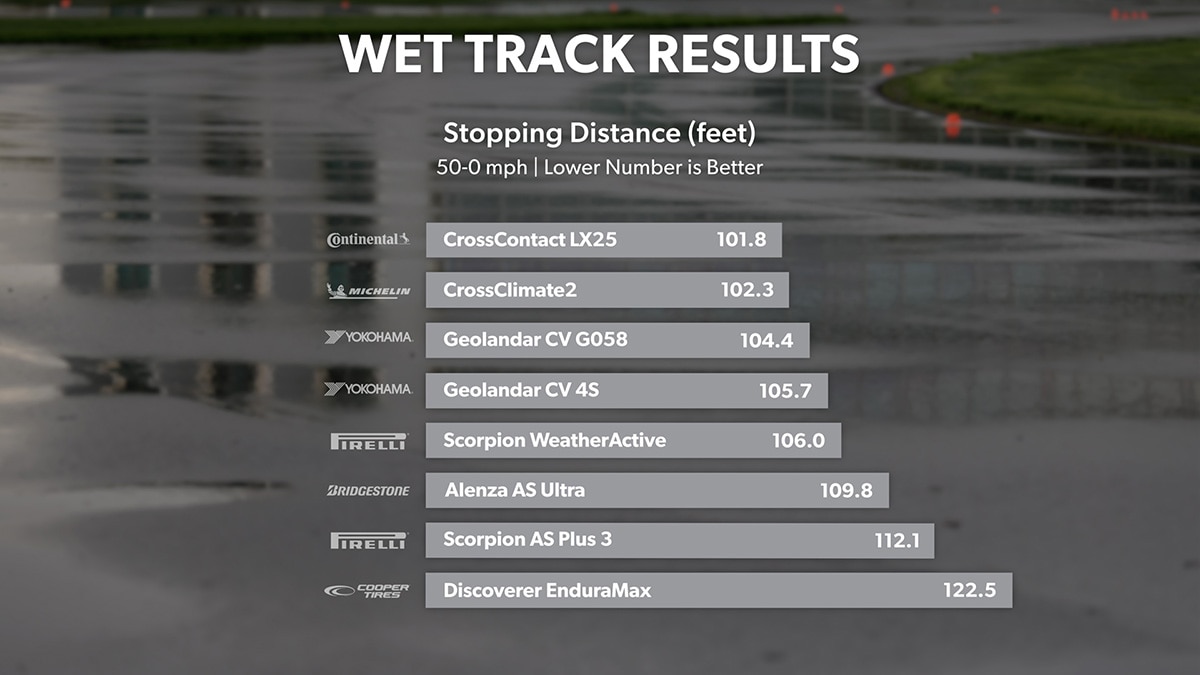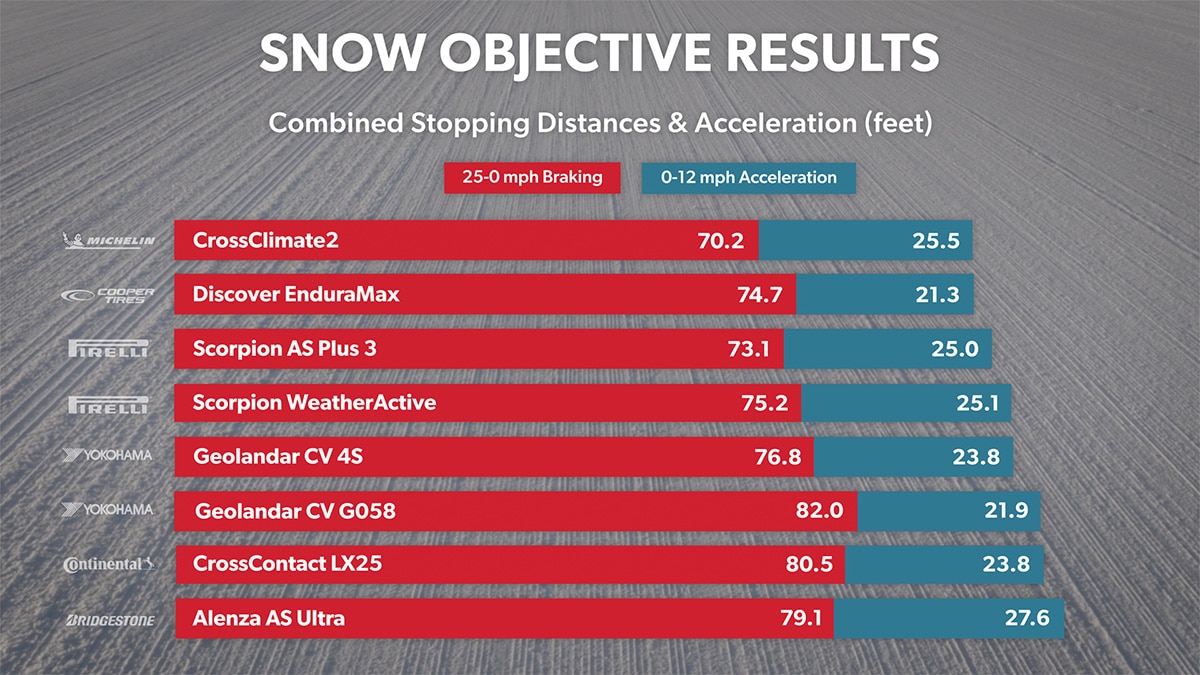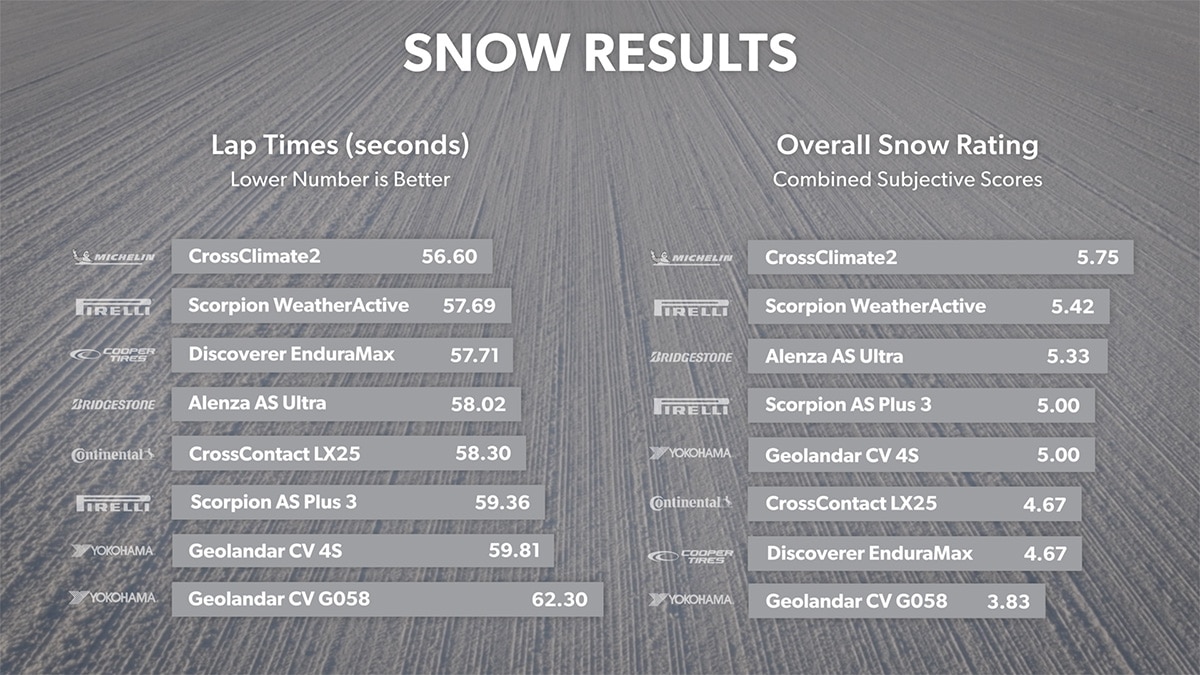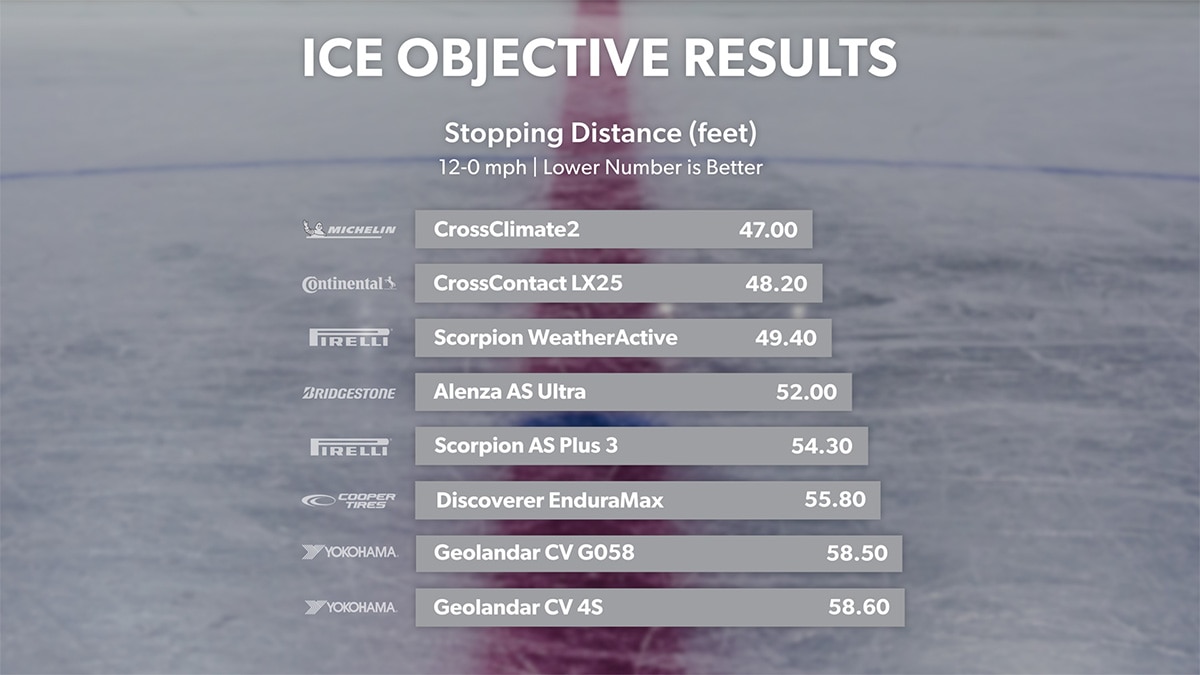This is our first Crossover/SUV Touring All-Season test of the year on our new Alfa Romeo Stelvio test vehicle. Naturally, we wanted to take a look at some fresh tires alongside some of the most popular options to see how everything stacks up. There are a lot of tires to check out - and while they're mostly from the same category, anyone familiar with tires and our testing will tell you that even the top-reviewed upper echelon of tires can have significant variations in road noise, comfort, wet grip, handling, and more. Furthermore, it's a mix of all-weather and non-3PMSF branded tires, and given the greater winter focus of the former, did it result in making meaningful tradeoffs anywhere else?
We'll introduce each, break down our experiences with them on our real-world road ride, then discuss their traction and subjective behavior on both a wet and dry track to understand how these tires act when pushed to their limits, mimicking the kind of high-speed emergency maneuvers you might need to deal with in a sudden crisis.
In addition to the limit-pushing data and experience we gather from running laps, this and future tests of non-performance tires will reference our new "emergency lane change" maneuver. On a dry surface, from a target speed of 45 miles per hour, our drivers will pass through 3 sets of cones. Each point is designed to illustrate how the tires handle the sudden, reactive swerves a person might make in an emergency situation. The 1st set indicates the point at which a person would react to the presence of an obstacle ahead, such as a stopped car, pedestrian, or a moose, leaving the "lane." The 2nd set is the target placement to avoid the obstacle, indicating the lane change has succeeded, the obstacle was avoided, but maybe the vehicle isn't where it's supposed to be now, so it acts as the trigger to suddenly overcorrect and swerve back to the 3rd set of cones, returning to the "lane." Our goal is to look beyond "one size fits all" testing and better represent the kind of real-world concerns drivers have to deal with.
In the snow, longitudinal acceleration and braking both felt fine for the category - capable of generating speed and authoritatively shaving it off despite the conditions. The tire's lateral traction allowed our drivers to feel confident in most situations, even mid-corner rotation was usable without any panic-inducing moments. The Alenza AS Ultra wasn't the best in any one objective measurement, but particularly in winter conditions, being predictable and controlled made for a reliable partner.
Bridgestone Alenza AS Ultra
The Alenza AS Ultra was, at the time of its release, intended as the top-of-the-line fitment for the Crossover/SUV Touring All-Season category, boasting Quiet Tracks and good treadwear. When our team took it out on the road, one of the most immediate issues noted by our testers was its lack of composure over impacts. It had a tendency to undulate, translating even small bumps to excess motion. It was, in a word, bouncy. Not to say it was wholly uncomfortable, but it didn't hide the imperfections on the road, either. Noise comfort was managed acceptably, nothing too loud, though there were some noticeable tone variations over different surfaces. The steering on-road was linear, responsive and direct, building weight appropriately.
When testing for more aggressive emergency maneuvers on our track, the steering was equally well-matched with the tire's traction capabilities. It wasn't the most accurate, but it's also not a performance tire. In spite of that, it was controllable through fast corners or rapid back-and-forth movements on a wet surface, critical for drivers dealing with unexpected situations in the rain. The braking could have been better; in both dry and wet, it trended toward the back of the pack in stopping distances. Ironically, it felt a bit more sluggish on the dry surface, with slower speeds and more input needed to react to our emergency lane change maneuver.
In the snow, longitudinal acceleration and braking both felt fine for the category - capable of generating speed and authoritatively shaving it off despite the conditions. The tire's lateral traction allowed our drivers to feel confident in most situations, even mid-corner rotation was usable without any panic-inducing moments. The Alenza AS Ultra wasn't the best in any one objective measurement, but particularly in winter conditions, being predictable and controlled made for a reliable partner.
Continental CrossContact LX25
A proven performer in the Crossover/SUV Touring All-Season category, the CrossContact LX25 has traditionally reviewed well in prior testing as well as with customers, racking up millions of miles driven. Ultimately, testing on the new platform would determine if this venerable tire still deserved a place among the latest and greatest out today. The first indication of positivity came from its ability to walk the line between stiffness, control, and comfort, dealing with impacts succinctly and minimizing body motion. The noise, too, was even, blending together sounds with little issue, with only some slight resonance over extra coarse sections of road.
The steering was quick to respond but weighty enough to feel right; it remained precise and useful throughout. Even with the lower traction and our testers pushing the tires to their limits on the wet track, it displayed very strong braking - numerically leading the other tires - yet was consistent and even through the deceleration. It felt planted and mostly neutral, keeping drivers in control without leaning too far toward either under or oversteer. It was equally capable when pushed for emergency maneuvers on a dry surface - and although it leaned just a little more into oversteer, it left little doubt of its well-adjusted nature overall.
On the snow, the CrossContact LX25 provided strong acceleration - but wasn't nearly as sure what to do with it afterwards. Our drivers got to speed just fine, but as soon as it came time to turn a corner, the lack of lateral grip and precise control reared up. The vague front end and weaker braking made cornering feel less stable, especially in tighter turns. It allowed some rotation, but overall, handling felt loose and less predictable. The drive felt less controlled and more demanding, making for a less confidence-inspiring experience. To its credit, it was one of the best tires when it came to braking on ice, coming to a stop only a foot away from the lead tire.
Cooper Discoverer EnduraMax
One of the first all-weather tires we're discussing in this test, the Discoverer EnduraMax boasts of better winter weather traction, but what did it have to give up to achieve that? On the road, it was firmest among those tested, transmitting both large and small impacts noticeably and causing vertical motion on undulations. Noise levels were moderate with some effective mitigation of cross-cut concrete resonance, but some higher volume or multi-tonal noise on other surfaces. Steering during the ride was light and not the most precise.
The shift to driving in the wet was a more drastic shift in experience, combining the already somewhat vague steering characteristics with a drop in traction. The Discoverer EnduraMax wasn't just a little off here, but in straight-line braking from 50mph, it was the worst in the test, taking over 10ft. longer to stop than the closest tire and 15ft or more from most of the other tires. The lack of grip on a wet surface rippled outward, taking longer to recover from mistakes and generally being less forgiving toward natural driving tendencies like combining braking and turning or kicking the tail out under acceleration. Most of these issues evaporated on dry surfaces, and it could manage our emergency lane change maneuver without much drama, even if the steering remained just as imprecise.
As an all-weather tire, the expectation would naturally be that the Discoverer EnduraMax would outperform the non-3PMSF branded tires in this test. In practice, it did deliver very capable acceleration - the best in the test - and authoritative turn-in, but getting into trouble faster isn't much of a boon. Past the initial take off, confidence disappeared mid-corner as it lacked lateral grip and consistency through the turn. It just felt vague and unpredictable, with persistent understeer, even in places other tires had held on. Braking felt merely adequate in the snow, contributing to an overall unrefined and less confidence-inspiring experience. Ice Braking was not exciting, but not terrible either, firmly middle of the pack at nearly 56 feet to come to a halt.
Michelin CrossClimate2
The CrossClimate2 is a titan of the Grand Touring All-Season category, with well over 25 million miles reported by customers across thousands of reviews, all the while remaining at, or near, the top of the category. It has tested well, it's popular, and it's an ideal tire to put through the paces on our new platform. Taking it out on the road, the ride was firm, communicating road features and small undulations without tossing the car around. Noise levels were moderate with multi-tonal sounds, and while it lacked the bassy impact noise of some other tires, the noise never really drifted away either. On a more positive note, the handling was good for a touring tire, light but mostly responsive and accurate, although it could benefit from a firmer on-center feel at lower speeds.
Traction and braking were strong on wet surfaces, offering a confident and predictable performance. Steering remained direct and responsive, and while not exceptionally sporty, that's hardly the point of a tire like this. The car remained stable and planted, exactly what you want in an emergency. In dry conditions, braking and steering were adequate when stressed, and it technically led the test to come to a stop from 50 mph. However, it struggled during the emergency lane change, pushing through the maneuver rather than truly handling it.
Taking the CrossClimate 2 out in the snow, it felt solid, predictable, and well-balanced, with strong acceleration and precise steering throughout. It maintained good grip through corners while still remaining recoverable at the limit. Braking was effective on packed snow, and while it wandered slightly under heavy braking, it didn't rotate much at all, letting our drivers lead it around by the nose. It put power down well and built speed quickly, especially on inclines. It was easily the leader both subjectively and objectively, with the strongest braking on both snow and ice - requiring a mere 47 feet to come to a stop on the ice.
Pirelli Scorpion AS Plus 3
Another categorical titan, the Scorpion AS Plus 3 has earned its place as one of the "go-to" options in Crossover/SUV Touring All-Season tires, and just like many of the others, we were eager to see how it would stack up in a new test. The good news is that, on the road, at least, it did not disappoint. The tire soaked up imperfections in the road, and with only momentary secondary motion, it was unquestionably comfortable to drive. The sounds of the road were kept to a minimum as well, staying consistently quiet and smoothly blending tones over almost the entire route. The steering, too, was particularly impressive - weighty and progressively building over the arc of a turn, responsive but not too eager or jerky.
Transitioning to testing in wet conditions, we found the steering was just as responsive, conforming nicely to more aggressive driving as easily as it handled on-road. It felt athletic and capable, recovering fluidly from mistakes, and would be a reliable partner in an emergency situation. In the dry, the Scorpion AS Plus 3 was stable and intuitive, gently treating excess at the limits of grip, allowing drivers to wrest control back smoothly. Braking perhaps could have been slightly better in both dry and wet, but it was hardly out of the average, and the overall performance was balanced and confident.
Once again, when it came to snowy conditions, the Scorpion AS Plus 3 felt nicely matched to the vehicle - control was intuitive, which made adjustments or turn-in a breeze. Acceleration wasn't amazing, but it was comfortably within the group. Likewise with braking - it was neither best nor worst - but the objective measurements speak to the main issue with it. It's great within its limits, and unfortunately, those limits were just a bit lower than some of the other tires. Right up to that point, it was fine, but beyond, the breakaway was a bit abrupt and you're along for an understeer controlled ride. Ice braking was again, middling, at 54 feet to come to a stop.
Pirelli Scorpion WeatherActive
The Scorpion WeatherActive is Pirelli's latest answer to the push for all-weather tires, carrying the 3PMSF symbol on its sidewall in preparation for winter. Is it able to perform comfortably for the rest of the year? At least on the road, the short answer is mostly a "yes." The ride tended slightly firmer, but more controlled, isolating the driver from, or making succinct work of bumps and cracks, but maintaining a satisfying level of ride comfort. Noise is similarly very well managed, though not without some minor tones and tread growl, although hardly intrusive. Steering on the road was on the sportier side: it was quick to respond off-center, appropriate in its build-up, and allowed our drivers to position themselves accurately.
In wet driving situations on a controlled track, it was, in a word, good. Slightly held back from greatness by a thin line that was, somewhat ironically, not helped by the sportier steering. Leaning too hard into the wheel during a corner could lead to early understeer, losing the delicate balance of steering input and grip. Frequently triggering ABS and/or Traction Control by stepping outside of that was easier to do than we would like, and in a panicked, emergency situation, it's not ideal. It's important to draw the distinction between "not ideal" and "bad" - the Scorpion WeatherActive had strong traction, enough that it could be counted on to dodge unexpected hazards, but in a competitive environment, even small distinctions matter.
It was a similar enough story in the snow - the acceleration was good in a straight line, braking was decent, steering was reactive, and it was pleasant to lead around the track. However, putting all of its aspects together made for a less polished, cohesive experience. Lateral traction was fine, provided steering inputs were disciplined and precise (which is a lot to ask of a panicked driver), but anything less and the fall-off was severe. Likewise with too much throttle at corner exit and it would push. Slowed down and driven reasonably it was good - even boasting one of the best ice stopping distances in the test, only a couple of feet from the leading tire at 49 feet.
Yokohama Geolandar CV G058
The Geolandar CV G058 may not be a name that rolls off the tongue, but it has earned its place as a reasonably popular tire with consumers in this segment and a strong performer in past testing. The last time we looked at this tire was back in 2020, so it was high time to revisit it on a new platform to see if it held up. We found a soft, compliant, and controlled ride on the road, handling big bumps well while still maintaining a somewhat sporty feel. Noise levels were very good, with minimal resonance and smooth performance on various surfaces. Though slightly lighter, the steering was direct and responsive, making it suitable for everyday driving in traffic.
Switching over to the wet surfaces, the steering continued to be accurate and quick to react, though again, on the lighter side. The traction was strong, with better-than-average braking, and it felt stable and planted, handling smoothly right up to its limit, where the traction break happened somewhat abruptly. Still, it felt like a reliable partner on low-grip surfaces and could be counted on within its limits. In dry conditions, it cleared our emergency lane change maneuver easily and continued to provide a mostly stable and confident ride with minimal understeer and responsive handling. The steering was linear and intuitive, making it easy to maneuver and correct mistakes.
In spite of its positive performance elsewhere, the Geolandar CV G058 just exhibited very low traction in the snow, and required a delicate touch to maintain control. It rotated easily from mid-corner through exit and was highly sensitive to throttle, often pushing wide or stepping out under braking. Steering offered little help, forcing constant corrections to manage stability. Recovering from loss of grip was slow, making the overall experience feel unpredictable and draining. Braking was weak everywhere, though particularly on icy surfaces, and the front axle just felt lacking in grip.
Yokohama Geolandar CV 4S
Yokohama's all-weather contribution to the Crossover/SUV Touring All-Season category was our first opportunity to test the Geolandar CV4S. The first impression on the road was a tire that was well-cushioned, composed, and capable of mitigating most small cracks and imperfections. Although larger impacts were more noticeable, they were also more concise, and the ride was largely controlled and comfortable. The same could not be said for the noise - it never rose to significant volumes, but some persistent resonance, pattern noise, and distinct tones on different surfaces did detract from the experience. The steering was as direct and responsive as its sibling in this test, but just a bit more satisfying heft.
On a wet surface, the steering remained just as reactive and accurate, working admirably with its sure-footed traction and reasonably strong braking. It was reliable on low-grip surfaces within its limits. In dry conditions, the emergency lane change maneuver posed little problem for it. Other than a minor tendency to understeer in corners under hard driving, an issue that would be nonexistent for an average person, it provided a confident, stable ride that would please most drivers.
Driving on the snow, the Geolandar CV4S turned in a decent performance overall, even if it didn't completely feel like it from the driver's seat. Acceleration felt confident enough, lateral grip was good, but front axle traction lacked the harmony with the rear needed for a more authoritative drive. It performed better than its brand counterpart, but still remained in the lower grip range, making a hard push through corners feel less assured. Braking was also adequate, and while it was more capable than it felt overall, its traits never fully came together into a seamless, natural experience. It did take the furthest distance on the ice to come to a stop - just over 11 feet further than the lead tire.
Summary Conclusion
There are a myriad of considerations when tire shopping, and even the "best" tire for one person may not fit your individual driving style, particular vehicle, or preferences. That's one of the many reasons we test: to explore the nuance and value across a wide spectrum of tires. Naturally, every tire has some strengths and weaknesses, and we've seen that repeatedly over the course of this test.
The Pirelli Scorpion AS Plus 3 is a perfect example of this, having led the test in subjective road ride scores, as well as its performance in the dry, but falling ever so slightly behind its competition in the wet and winter conditions. Not drastically so, but enough that it made a noteworthy difference. Contrarily, Pirelli's Scorpion WeatherActive makes an interesting counterpart to the Scorpion AS Plus 3, aiming for all-weather performance and practically matching its kin in on-road comfort, but not quite on the same level when pushed. During our snow driving, the Scorpion WeatherActive felt similarly unpolished. It was objectively strong on individual metrics or performance, but not as much when it came to blending them together in what felt like a cohesive whole. If that sounds like a back-handed compliment, it is - but is still a compliment nonetheless. Michelin's CrossClimate2 is undoubtably a focused tire - its directional design supports a goal of powerful wet and snow traction, and it mostly fulfills that mission well while also managing to provide decent on-road manners. Unfortunately, time and competition have caught up with it in many ways, and Michelin will need to continue to innovate and iterate to stay on top.
Yokohama's Geolandar CV4S shows us a tire that leans more into the performance side of the category, with very strong handling, wet and dry traction, and some reasonable winter driving, but not focusing quite as much on the luxury aspects of commuting. It hasn't been neglected, certainly, but some noticeable tonal noise in particular keep it from hitting all the marks. The Continental CrossContact LX25 was another tire that understands the general "touring" mission of not being too specialized by focusing on excellent wet and dry performance to keep drivers safe, while maintaining a comfortable, and notably quiet, on-road presence. Its winter performance is less laudable, but 3 out of 4 seasons aren't too bad. Yokohama's Geolandar CV G058 might have the distinction of being one of least compellingly named tires on this list, reading more like a serial number than a top-end product, but it's similarly so well-rounded and capable at what it does that there's few situations it wouldn't handle well - with the exception of winter driving. It's a tire that's worth considering, but if you live in a cold climate, it's also worth keeping a separate set of tires for the cold season.
The Bridgestone Alenza AS Ultra is a pretty good tire: not particularly loud, or uncomfortable or even especially weak in wet or dry weather when pushed. However, that is ultimately its Achilles' heel; it's a pretty good tire, but it's also just that. It just doesn't stand out in an already crowded field, apart from its better-than-average handling of winter weather. Finally, the Cooper Discoverer EnduraMax does manage to stand out, though not quite for the right reasons. To the tire's credit, it is capable in the dry and was reasonably comfortable during our road ride. However, it was not a compelling tire in the snow, and particularly struggled in the wet, especially compared to its peers, taking almost 21 ft further than the test leader to come to a stop from 50mph. That kind of gulf is simply too significant to hand wave away.

